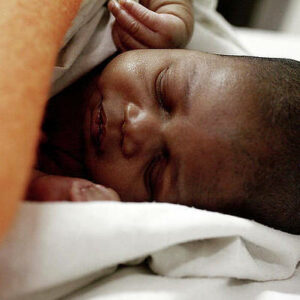FAQ - Frequently Asked Paternity Test Questions
What kind of testing is performed to determine paternity?
DNA testing is performed. DNA (DeoxyriboNucleic Acid) is the genetic material found in the cells of your body. A person receives half of their genetic material from their biological mother and the other half from their biological father. Paternity testing is performed using a technology called PCR (Polymerase Chain Reaction), in which specific areas of a person’s DNA—called genetic loci—are amplified, analyzed and compared to those of another person to determine whether they share genetic markers in common and whether they are likely to be genetically related. Non-DNA based genetic tests, such as blood typing, are no longer performed for present-day paternity and family relationship testing
How do you test DNA?
To test DNA for determination of paternity and other family relationships, buccal swab samples are used almost exclusively as the source of the DNA. Buccal swabs are cheek cell samples that are collected by gently rubbing cotton swabs on the inside of the mouth. In the laboratory, DNA is extracted from the cheek cells on the swabs and then analyzed using sophisticated instrumentation to identify the donor’s genetic markers at specific chromosomal locations. Largely due to the fact that they are non-invasive and painless, buccal swabs replaced blood samples as the specimen of choice about 20 years ago. Today, blood samples are usually only tested if buccal swabs are unavailable. In the event that buccal swab or blood sampling is not possible, other types of samples may also be tested.
Is a blood test more accurate than a swab test?
There is no difference in the accuracy of DNA tests performed using blood versus buccal swabs. This is because the cells of your cheek (and all other types of bodily tissue) contain the same DNA as the cells of your blood.
How is paternity determined in a DNA test?
he genetic loci analyzed contain DNA sequences known as short tandem repeats (STRs)—short, repeating units of DNA. For each person, the number of repeats present at each genetic locus is variable and is inherited from their biological parents. For each genetic locus, each person has two genetic markers, or alleles (alternate forms of the DNA sequence): one allele is inherited from their biological mother and one allele is inherited from their biological father.
The test result report lists the allele sizes (number of repeats) for the mother (if tested), child, and alleged father at each genetic locus. By testing the mother, we can determine which allele the child inherited maternally. The allele that the child received from its biological father (called the obligate paternal allele) can therefore be determined by subtracting the mother’s contribution to the child’s DNA. If the alleged father does not possess the obligate paternal allele at three or more genetic loci, then he is excluded (ruled out) as the biological father. If only the child and alleged father are tested, and they do not share any alleles in common at three or more loci, then the alleged father is also excluded. When the alleged father possesses the obligate or possible paternal alleles at all loci tested, then he is not excluded (not ruled out) as the biological father. Based on these genetic findings, a probability of paternity is calculated and reported.
How accurate is a DNA paternity test?
Our paternity tests are performed using state-of-the art forensic DNA typing technology and have an accuracy of over 99.9%.
Why can’t DNA tests prove with 100% certainty that a tested man is the father?
A DNA test cannot prove that a tested man is the biological father of a child with 100% certainty because the possibility that the tested man is matching the child due to random chance (coincidence) can never be completely ruled out. However, most courts consider a probability of paternity of 99% or greater as strong and sufficient evidence of paternity. Current DNA test batteries typically produce probabilities of paternity greater than 99.9%
What is the Paternity Index?
The Paternity Index (PI) is the genetic odds in favor of an alleged father being the biological father of the child. A PI is calculated for each genetic locus, and represents the likelihood that the alleged father contributed the paternal alleles versus an untested, unrelated, random man in the population. The Combined Paternity Index (CPI), which is calculated by multiplying the individual PIs together, summarizes the overall strength of the genetic evidence.
For example, if the CPI is 100,000, it means that the alleged father is 100,000 times more likely to be the biological father of the child than an untested, unrelated, random man in the population. In other words, the chance that he has matched the child by pure coincidence would be 1 in 100,000. If the alleged father does not possess the paternal alleles of the child at three or more loci, then the PI at each non-matching locus is 0, the CPI is 0, and the alleged father is excluded as the biological father.
What is Prior Probability?
The issue of paternity depends not only on consideration of the genetic evidence (the Combined Paternity Index), but on also consideration of the non-genetic evidence, which includes fertility, access of the tested man to the mother, the issue of other possible fathers, etc. As non-genetic evidence is based on events occurring near the time of conception, it forms the basis of Prior Probability, which is the probability of paternity before testing.
To maintain neutrality, laboratories assume that, before testing, the tested man has a 50/50 chance of being the father (i.e. prior probability = 50%, or 0.5). After testing, however, the probability of paternity changes due to the newly-obtained genetic evidence. If the genetic tests exclude the tested man, then the probability of paternity will drop to 0%. If the DNA tests do not exclude the tested man, then the probability of paternity will increase to more than 99%.
How is the Probability of Paternity determined?
The Probability of Paternity is the overall likelihood of paternity expressed as a percentage. It is computed using a mathematical formula that considers all of the evidence in a case—both genetic evidence (Combined Paternity Index) and the non-genetic evidence (Prior Probability). In this computation, the Combined Paternity Index is “converted” to a percentage based on an unbiased assumption that the Prior Probability is 50% (or 0.5)—a neutral value which means that, prior to DNA testing, the alleged father is considered equally likely to be the biological father as he is not to be the biological father. A DNA test result with a Probability of Paternity of 0% means that the alleged father is excluded, or cannot be the biological father. A DNA test result with a Probability of Paternity of 99% or greater means that the alleged father is most likely the biological father.
What if two possible fathers of the child are related to each other?
Because related possible fathers share some of their genetic markers by inheritance, it is more difficult to distinguish between them than between unrelated possible fathers. For example, a man shares 50% (1 out of 2) of his inherited genetic markers with his biological father, brothers, and sons, and 25% (1 out of 4) of his inherited genetic markers with his biological grandfathers, uncles, nephews, and half-brothers. If two possible fathers are identical twins, then genetic tests cannot distinguish them. The standard statistical analysis of the test results assumes that other possible fathers are not related to the tested man. If there is reason to believe otherwise, then this must be brought to our attention so that appropriate testing and statistical analysis can be performed.
What if the alleged father is deceased or unavailable?
If a postmortem blood or tissue specimen from an alleged father has been collected and saved (for example, law enforcement agency, or hospital), it can be tested to determine its suitability for DNA analysis. If a suitable postmortem specimen is not available, paternity can be addressed by testing close relatives of the alleged father, such as his parents, siblings and undisputed children, who will share some of the alleged father’s genetic markers by inheritance.
Can paternity testing be done without the mother?
Yes. However…
(1) From a scientific standpoint, testing the mother is advantageous because it enables the lab to determine which half of the child’s genes came from her, and therefore which half came from the father. This increases the conclusiveness of a paternity test. Although in most routine paternity tests conclusive results are also obtained when the mother is not tested, there are certain situations in which testing the mother is very important and strongly recommended, Consider a case in which a newborn child is to be tested with an alleged father who has not seen the child before and who is concerned that the mother might substitute another child in order to achieve a desired test outcome. In such cases, testing the mother enables the lab to confirm that the child tested is indeed hers, because they would match each other genetically. This type of concern has also been raised in some adoption cases, in which an alleged father seeking parental rights to a newborn child he has never seen is concerned that the presumptive adoptive parent(s) may substitute another infant in the test, with the intention of obtaining a paternity test result that excludes the alleged father. Including the biological mother in the test eliminates this potential problem. Finally, because it allows precise determination of a child’s paternal markers, testing the mother is of tremendous value in increasing the conclusiveness of more complex relationship tests, such as sibling tests, grandparent tests, avuncular tests, and tests involving closely-related possible fathers (such as brothers).
(2) From a legal standpoint, for legally-admissible paternity tests, if the mother will not be tested, then consent for testing any minor children (or legally-incapacitated adults) must be provided by the mother, by another adult having the legal authority to provide consent, or by court-order. Evidence of legal authority or legal guardianship must be provided.
Is there a minimum age for a person to be tested?
No. There is no minimum age requirement to collect a person’s DNA sample. We routinely test newborns and very small infants.
Can paternity testing be done before the child is born?
Yes. Prenatal paternity testing can be performed in two ways: invasively or non-invasively. The most common invasive method involves a procedure called amniocentesis, in which a physician collects (using a long needle) a small amount of amniotic fluid from the womb of the expectant mother between 15 – 25 weeks post-conception. Amniotic fluid contains cells from the fetus but not cells from the mother, and is analyzed using the same established technology as standard (non-prenatal) paternity tests. As a result, paternity tests performed using amniotic fluid samples are fully defensible in a court of law, provided that all samples were collected under a strict chain of custody. Due to potential risks involved, consultation with an obstetrician is strongly advised when considering amniocentesis.
Non-invasive prenatal paternity testing, a safer alternative which has become available recently, permits detection and analysis of fetal DNA markers using a blood sample collected from the expectant mother on or after 8 weeks post-conception. While accurate, non-invasive prenatal paternity tests have not yet been approved by AABB, have had little exposure in the courts, and thus may not be the better choice if legal admissibility of the results is critical. Prenatal paternity tests are much more costly (usually $500 – $1000 more) than paternity tests performed after the child is born. Health insurance may cover the cost of collection of prenatal samples, but usually only if the procedure is also being performed for medical reasons (such as testing for Down syndrome).
Can DNA testing address genetic relationships other than paternity?
Yes. DNA testing provides general information regarding biological relationships. Thus, questions such as: “Are these two individuals related as full siblings or half siblings?”, “Are the twins identical or fraternal?” and “Do these two individuals share the same maternal lineage?” can be addressed. The amount of genetic information that can be obtained—and the likelihood of conclusiveness of such DNA tests—may vary from case to case. Consultation with our MANAGER is therefore advised before scheduling an appointment for such DNA tests.
Can DNA testing distinguish between identical twins?
No. By definition, identical twins share 100% of their genetic markers, and no genetic test can distinguish them.
Will diet, drugs, alcohol, or medications affect the test results?
No. DNA tests are not affected by food, drugs, alcohol, or medications. There is no need to abstain from eating, drinking or taking medications prior to your appointment, with one exception: If you are a mother and are breast-feeding a baby who will be tested, please refrain from breast-feeding 30 minutes before the baby’s sample is to be collected. This is because breast milk contains the mother’s DNA. If there is residual breast milk in the baby’s mouth when its samples (buccal swabs) are collected, then there is a possibility that the baby’s sample could be contaminated with the mother’s DNA and not produce a clear test result. If this were to happen, sample recollection would be necessary.
Paternity Testing – Making an Appointment
How do I set up a paternity test?
Do we need a doctor’s request or a court order to get a DNA test?
Where do I go to have my DNA sample collected?
What if the people to be tested live in different places?
What happens at the sample collection appointment?
Payment and Policies
How much does a paternity test cost?
What kinds of payment options do you offer?
Does insurance cover the cost of a paternity test?
If one party pays for the testing, why does the other party get the results?
How do you ensure my privacy?
Paternity Testing – Release and Acceptance of Results
When will my test results be ready, and how will I receive them?
What information is included with the test results?
Can the test results be used for legal purposes?










